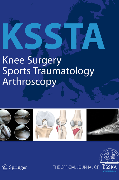
Similar 2 Year Clinical Outcomes With Attune vs. PFC Sigma Prosthesis in TKA for Severe Knee OA .
Mid-term results show no significant difference in postoperative clinical outcome, pain and range of motion between a well-established total knee arthroplasty design and its successor: a prospective, randomized, controlled trial
Knee Surg Sports Traumatol Arthrosc . 2021 Mar;29(3):827-831.Two hundred patients scheduled to undergo a primary total knee arthroplasty (TKA) for severe knee osteoarthritis were randomized to receive an Attune prosthesis (n=100) or Press Fit Condylar (PFC) Sigma prosthesis (n=100). Outcomes of interest included the following: Knee Society Knee and Function Scores, the Western Ontario and McMaster Universities Osteoarthritis Index (WOMAC), pain on a Visual Analogue Scale (VAS0, and range of motion (ROM). All outcomes were measured at 2-years follow-up. Results demonstrated that all outcomes were not statistically significantly different between the 2 prosthesis systems (p>0.05 for all).
Unlock the Full ACE Report
You have access to 4 more FREE articles this month.
Click below to unlock and view this ACE Reports
Unlock Now
Critical appraisals of the latest, high-impact randomized controlled trials and systematic reviews in orthopaedics
Access to OrthoEvidence podcast content, including collaborations with the Journal of Bone and Joint Surgery, interviews with internationally recognized surgeons, and roundtable discussions on orthopaedic news and topics
Subscription to The Pulse, a twice-weekly evidence-based newsletter designed to help you make better clinical decisions
Exclusive access to original content articles, including in-house systematic reviews, and articles on health research methods and hot orthopaedic topics
































































